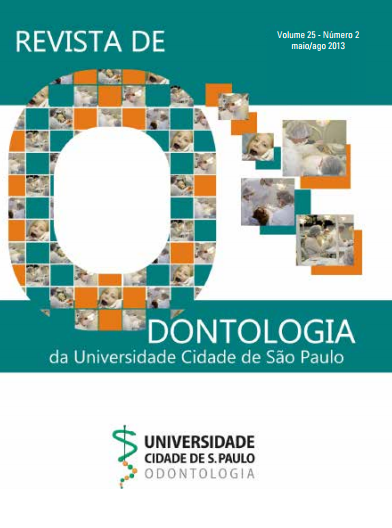Epilepsia: condutas na prática odontológica
DOI:
https://doi.org/10.26843/ro_unicid.v25i2.328Palavras-chave:
Assistência Odontológica para Doentes Crônicos, Tratamento de Emergência, Epilepsia.Resumo
A epilepsia e seu tratamento podem apresentar questões específicas para os pacientes que recebem atendimento odontológico. A segurança de anestésicos locais, o cuidado com a luz do refletor, as interações medicamentosas, o crescimento gengival, os traumatismos durante as convulsões, o tipo de prótese mais indicada, os fármacos para intervir em situação de emergência, são alguns pontos que o cirurgião-dentista deve conhecer. Esta revisão de literatura é uma proposta de oferecer orientação para o tratamento odontológico em pacientes epiléticos. A abordagem segue desde a importância da anamnese até os efeitos dos fármacos presentes na rotina do cirurgião-dentista.Downloads
Referências
Aragon CE, Hess T, Burneo JG. Knowledge and attitudes about epilepsy: a survey of dentists in London, Ontario. J Can Dent Assoc. 2009 Jul;75(6):450.
Reynolds EH. The ILAE/IBE/WHO epilepsy global campaign history. International League Against Epilepsy. International Bureau for Epilepsy. Epilepsia. 2002;43 Suppl 6:9-11.
Robbins MR. Dental management of special needs patients who have epilepsy. Dent Clin North Am. 2009 Apr;53(2):295-309, ix. 4. Proposal for revised classification of epilepsies and epileptic syndromes. Commission on Classification and Terminology of the International League Against Epilepsy. Epilepsia. 1989 1989 Jul-Aug;30(4):389-99.
Dua T, de Boer HM, Prilipko LL, Saxena S. Epilepsy Care in the World: results of an ILAE/IBE/WHO Global Campaign Against Epilepsy survey. Epilepsia. 2006 Jul;47(7):1225-31.
Sander JW, Shorvon SD. Epidemiology of the epilepsies. J Neurol Neurosurg Psychiatry. 1996 Nov;61(5):433-43.
Young SI. Management of some medical emergencies in the dental office. J Can Dent Assoc (Tor). 1965 Mar;31:185-91.
Alldredge BK, Gelb AM, Isaacs SM, Corry MD, Allen F, Ulrich S, et al. A comparison of lorazepam, diazepam, and placebo for the treatment of out- -of-hospital status epilepticus. N Engl J Med. 2001 Aug;345(9):631-7.
Herzog AG, Harden CL, Liporace J, Pennell P, Schomer DL, Sperling M, et al. Frequency of catamenial seizure exacerbation in women with localization-related epilepsy. Ann Neurol. 2004 Sep;56(3):431-4.
Maldonado A, Ramos W, Pérez J, Huamán LA, Gutiérrez EL. [Convulsive status epilepticus: clinico-epidemiologic characteristics and risk factors in Peru]. Neurologia. 2010 Oct;25(8):478-84.
Fiske J, Boyle C. Epilepsy and oral care. Dent Update. 2002 May;29(4):180-7.
Vorkas CK, Gopinathan MK, Singh A, Devinsky O, Lin LM, Rosenberg PA. Epilepsy and dental procedures. A review. N Y State Dent J. 2008 Mar;74(2):39-43.
Silverman S. Oral cancer: complications of therapy. Oral Surg Oral Med Oral Pathol Oral Radiol Endod. 1999 Aug;88(2):122-6.
Károlyházy K, Kovács E, Kivovics P, Fejérdy P, Arányi Z. Dental status and oral health of patients with epilepsy: an epidemiologic study. Epilepsia. 2003 Aug;44(8):1103-8.
Károlyházy K, Kivovics P, Hermann P, Fejérdy P, Arányi Z. Five-year follow- -up of oral health and seizure condition of patients with epilepsy: a prospective observational study. Community Dent Health. 2010 Dec;27(4):233-7.
Sander JW, Perucca E. Epilepsy and comorbidity: infections and antimicrobials usage in relation to epilepsy management. Acta Neurol Scand Suppl. 2003;180:16-22.
Patsalos PN, Perucca E. Clinically important drug interactions in epilepsy: general features and interactions between antiepileptic drugs. Lancet Neurol. 2003 Jun;2(6):347-56.
.Kennedy BT, Haller JS. Treatment of the epileptic patient in the dental office. N Y State Dent J. 1998 Feb;64(2):26-31.
Klar LA. Gingival hyperplasia during dilantin-therapy; a survey of 312 patients. J Public Health Dent. 1973;33(3):180-5.
Sinha S, Kamath V, Arunodaya GR, Taly AB. Phenobarbitone induced gingival hyperplasia. J Neurol Neurosurg Psychiatry. 2002 Nov;73(5):601.
Anderson HH, Rapley JW, Williams DR. Gingival overgrowth with valproic acid: a case report. ASDC J Dent Child. 1997 1997 Jul-Aug;64(4):294-7.
Addy V, McElnay JC, Eyre DG, Campbell N, D'Arcy PF. Risk factors in phenytoin-induced gingival hyperplasia. J Periodontol. 1983 Jun;54(6):373- 7.
.Modéer T, Dahllöf G. Development of phenytoin-induced gingival overgrowth in non-institutionalized epileptic children subjected to different plaque control programs. Acta Odontol Scand. 1987 Apr;45(2):81-5.
Rood JP. Local anaesthesia and the medically compromised. Dent Update. 1991 Oct;18(8):330-2, 4.
Robb ND. Epileptic fits under intravenous midazolam sedation. Br Dent J. 1996 Sep;181(5):178-9.
Sanders BJ, Weddell JA, Dodge NN. Managing patients who have seizure disorders: dental and medical issues. J Am Dent Assoc. 1995 Dec;126(12):1641-7.
.Percival T, Aylett SE, Pool F, Bloch-Zupan A, Roberts GJ, Lucas VS. Oral health of children with intractable epilepsy attending the UK National Centre for Young People with Epilepsy. Eur Arch Paediatr Dent. 2009 Jan;10(1):19-24.
Costa AL, Yasuda CL, França MC, Morita ME, Cendes F. Refractory epilepsy is highly associated with severe dentoalveolar and maxillofacial injuries. Epileptic Disord. 2011 Mar;13(1):61- 4.
Nonato ER, Borges MA. Oral and maxillofacial trauma in patients with epilepsy: prospective study based on an outpatient population. Arq Neuropsiquiatr. 2011 Jun;69(3):491-5.
Rucker LM. Prosthetic treatment for the patient with uncontrolled grand mal epileptic seizures. Spec Care Dentist. 1985 1985 Sep-Oct;5(5):206-7.
.Cune MS, Strooker H, van der Reijden WA, de Putter C, Laine ML, Verhoeven JW. Dental implants in persons with severe epilepsy and multiple disabilities: a long-term retrospective study. Int J Oral Maxillofac Implants. 2009 2009 May-Jun;24(3):534-40.
Patsalos PN, Fröscher W, Pisani F, van Rijn CM. The importance of drug interactions in epilepsy therapy. Epilepsia. 2002 Apr;43(4):365-85.
Goulden KJ, Dooley JM, Camfield PR, Fraser AD. Clinical valproate toxicity induced by acetylsalicylic acid. Neurology. 1987 Aug;37(8):1392-4.
Miners JO. Drug interactions involving aspirin (acetylsalicylic acid) and salicylic acid. Clin Pharmacokinet. 1989 Nov;17(5):327-44.

